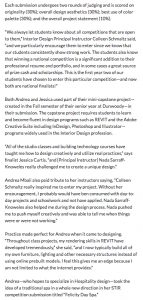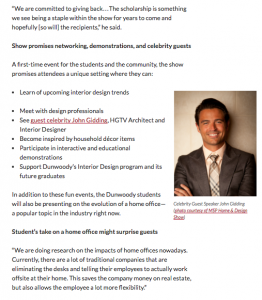
Several simple changes to my writing dramatically transformed Dunwoody College’s news blog and social media reach over the past year.
Why learn social media and web writing for higher ed?
Confession #1: When I began my position as a Marketing Communications Coordinator at Dunwoody College, I had never before written a blog story. Sure, I had whipped up 35 page academic papers in college and posted my fair share of life happenings to Facebook, but crafting an interesting, SEO-friendly, high performing, news-worthy story — especially on behalf of a college — was not in my wheelhouse.
This sums up rather nicely why I chose to enroll in Higher Ed Experts’ Social Media & Web Writing for Higher Ed course in 2015.
During my four weeks in the program I learned more than I could have imagined. From re-designing academic program pages to creating various user personas, I was being challenged in the best ways possible.
But, surprisingly, the real test came after the class.
I had all this new information. Now, what to do with it?
I began by diving right in.
I started by incorporating the little things — improvements that I knew I could easily fix.
What I wasn’t expecting is how much of a difference they would make.
I followed 3 easy steps to improve my writing on the blog and social media.
#1 Break up the text: Write a deck and use subheadings
The first change I made to our news blog stories was the incorporation of subheadings.
Sounds minor, but they helped immensely. Not only were subheadings helping our marketing team of three to write, transition, and organize stories better, they were improving our SEO, and our readability. Not to mention the blog looked much less intimidating.
These before and after screenshots below show how different my stories looked before I started to break up quotes, add more photos and use subheadings as I had learned in the class:
Writing “secondary headlines” or decks — a recent change to our blog – has also been helping, especially in generating meta-data.
Which brings me to confession #2: Prior to this class, I did not add or edit meta-data on our blog stories.
I didn’t have any experience with it, so I honestly did not realize its value — and how much not updating it, could hurt.

As you can see, without meta-data fields, the story “teaser” or summary was simply pulling our blog tags and the first few words of the headline. It added no context to the story and looked rather sloppy.
But, editing the meta-data was only one part of the problem. The second quickly became, what to put there?
This is where the deck comes in. By identifying the second point or layer of my story — and several important keywords — I was able to add an additional piece of information for readers, giving the post a much cleaner look:

#2 Think about your audience before you write the story
Would a prospective student, partner, or employee care about this story?
The next big change I tackled was how I was developing and writing the actual story itself.
Before this class on web writing for higher ed, I never really asked “why am I writing this?”
I simply came across a campus happening and summarized what happened in our blog. I then shared the post to social media and voila — a story!
But, I learned an important lesson in this course: what I was writing wasn’t a story. I wasn’t storytelling — I was reporting. Period.
So, I began to challenge myself to take a topic and turn it into something someone will not only care about, but want to share with others.
The best example of this new approach came late last year when our Construction Management Program Manager told me she was interested in having a blog story written about her two new faculty members.
I loved the idea of featuring new faculty members. Then, I took pause. Would our readers care that we hired two new employees? Probably not.
The easy solution would have been to just not write the story. Instead, I asked myself, what part of this story would be valuable to our readers? What would they want or care to know?
And, the light bulb moment happened.
We were hiring new faculty members because our program was growing. Our program was growing because the construction industry was booming. Because the construction industry was booming, the City of Minneapolis needed construction project management workers… and they needed them fast!
Now, what can be more interesting to a prospective student than the fact that in just two to four years, our school can nearly promise them a respectable, secure, and high-paying job?
The story went from the “should we do this” pile to “this is how we do this” pile. It was a hit — and a game-changer.
Story direction is everything. And by writing stories your audience cares about, you can earn yourself some pretty impressive Facebook statistics:

#3 Carefully craft your social media copy
On social media, get to the point but don’t give everything away.
The final major change I’ve made after taking this course was refining our story pitch.
I had improved the look of the post, identified the best, most relevant angle. It was time to get people to want to read it.
I’m sure I’m not the first person whose found generating micro-content to be tricky.
When I first began sharing blogs on social media, I had the horrible habit of over-explaining. Ultimately, my copy would end up being the shortened version of the story.
But, who is going to take the time to read three paragraphs on Facebook? And, why would someone click the story, if I had already told them what happened?
Before the class:

Example of burying the lead and giving the story away.
I was also struggling with Twitter — the epitome of micro-content.
I was missing opportunities to grab our reader’s attention and tag industry partners. As a result, we weren’t reaching new audience members. We weren’t engaging with them either.
Before the class:

After the class:

Both tweets discuss articles in the same magazine, written by the same faculty member. The difference in reach is likely due to getting to the point quicker, and the tagging of the author and the magazine.
By shortening up my “intro” and making more of an effort to intrigue readers, I saw dramatic improvements to my posts:
Before the class:

This post promoting our latest YouTube video is filled with a lot of jargon and the point of the post comes a little too late in the copy.
After the class:

This recent post of a different YouTube video is a great example of being short, sweet—and just a little bit cheeky. Notice the difference in reach and engagement.
I was also starting to feel much more comfortable and confident in writing and sharing stories.
In fact, in the nine months after the class, I wrote more than two times the number of blog stories I had written in the nine months prior. Our marketing team also posted much more often. We even developed a content calendar (another helpful hint from the course!) to help plan when we would post what.
Big results in reach and engagement
Not surprisingly, this caused our Facebook following and reach to grow. In August of 2015 (the month prior to taking the course), we had a monthly post reach of 11,405, with a total of 1,804 likes on Facebook.

Flash-forward to July of 2016, and you’ll see our monthly post reach was 17,494, with a total of 2,330 likes — a 29%-growth in our following.
This post reach increase wasn’t just a coincidence: we’ve seen it over the past few months:

Our Twitter following has also exploded. In August of 2015, we had a total of 771 followers. In July of 2016, our followers increased to 1,046 — a 36%-growth.
Our tweet impressions have followed the same trend. In August of 2015 we received 7,606 impressions. In July of 2016, our tweet impressions were 12,871 — a rise relatively consistent throughout the year:
Now, I am in no way saying I’ve become a “guru” in writing for the web/social media. In fact, as I was writing this blog, I even noticed several opportunities for improvement on our best performing Facebook/Twitter posts. It’s a process 🙂
But, this class showed me where to start and what to change to get better results.
Meet the Author: Allie Swatek
Allie Swatek is the Content Marketing Specialist at Dunwoody College of Technology. She is also a graduate of Higher Ed Experts’ professional certificate program in Social Media and Web Writing for Higher Ed
Tags: Higher Ed Marketing Memos, Higher Ed News
